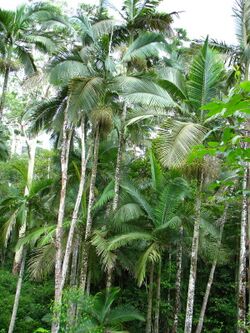Biology:Archontophoenix maxima
| Walsh River palm | |
|---|---|

| |
Script error: No such module "Conservation status".
| |
| Scientific classification Error creating thumbnail: Unable to save thumbnail to destination
| |
| Kingdom: | Plantae |
| Clade: | Tracheophytes |
| Clade: | Angiosperms |
| Clade: | Monocots |
| Clade: | Commelinids |
| Order: | Arecales |
| Family: | Arecaceae |
| Genus: | Archontophoenix |
| Species: | A. maxima
|
| Binomial name | |
| Archontophoenix maxima | |
Archontophoenix maxima, the Walsh River palm, is the largest species of the genus Archontophoenix. It is endemic to Queensland, Australia .[2][3] This robust palm grows in rainforest at altitudes between 800 and 1,200 m (2,600 and 3,900 ft) on the Walsh River and the adjacent Mount Haig Range in the Atherton Tablelands at approximately 17° South latitude.[3]
Description
The Walsh River palm grows up to 25 m (82 ft) metres tall, with a trunk up to 30 cm (12 in) in diameter with an expanded base. The rigidly-held, erect leaves are up to 4 m (13 ft) long, and have a slight sideways twist. The massive branched inflorescence is up to 1.5 m (5 ft) long, and bear white flowers. When ripe, the fruit is red and 13–15 mm (0.5–0.6 in) in length. The flowers closely resemble those of A. alexandrae.
References
- ↑ "Archontophoenix maxima". Centre for Plant Biodiversity Research, Australian Government. https://id.biodiversity.org.au/name/apni/170885.
- ↑ 2.0 2.1 "Archontophoenix maxima Dowe". Royal Botanic Gardens, Kew. https://powo.science.kew.org/taxon/urn:lsid:ipni.org:names:979671-1.
- ↑ 3.0 3.1 "Archontophoenix maxima". Centre for Australian National Biodiversity Research (CANBR), Australian Government. 2020. https://apps.lucidcentral.org/rainforest/text/entities/Archontophoenix_maxima.htm.
<ref> tag with name "DESQLD" defined in <references> is not used in prior text.External links
- View a map of historical sightings of this species at the Australasian Virtual Herbarium
- View observations of this species on iNaturalist
- View images of this species on Flickriver
Wikidata ☰ Q4787338 entry
 |


